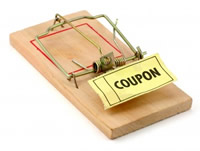Now that summer is here do you find yourself shopping more? It’s the long days and great weather. You feel more energized, more optimistic, and more willing to go somewhere and spend money.
Retailers are counting on your great mood to maximize their bottom lines. They’re using sales to get you into the store and tricks of the trade to get you to buy more products than you had planned.
Let’s look at the grocery store.
You walk in to buy milk and bread, and you walk out with two full bags, having spent way more than you planned.
How did that happen? Let’s look at a common marketing scheme. Most grocery stores have products they call loss leaders. These are often common staples, like milk or bread. They know these bring you into the store, so they’re willing to take a loss knowing that you’ll buy something else that will make up the difference. How can they be so sure? Product placement is a science and could be an article in itself. Just know that you’ll be tempted to open your wallet.
Here’s another common marketing scheme. Most flyers and sales offer a better price for multiple quantities – you were only going to buy one, but then you saw the sticker offering 50% off the second item, so you bought two. Some grocery stores offer mix and match sales, like 10 for $10 deals in the snacks, frozen food, or canned aisles. The store is obviously trying to get you to buy more than you intended, and because these deals are almost always on foods that will keep, you may feel that it doesn’t hurt to stock up. Does it work for the store? Yes, most people can’t pass up this type of deal.
What can you do about it? You can go to that grocery store, just buy the specific products you need, and leave.
Let’s look at other stores.
“Store Credit” is another trick to get you to spend money. At checkout, you may be offered an additional discount if you use store credit or even free financing for a specific period. They aren’t dong you any favors. They are counting on you having to make multiple payments with interest.
Furniture is a great example of free financing (no payment until 2015). You may be thinking you need a new bed, but with this offer you end up buying the bed with matching night stands and dressers because you have years to pay it off. Of course, the store is betting against you. They don’t believe you’ll actually pay it off on time, then they’ll collect interest going back to the date of purchase.
Let’s go back and take closer look at product placement. It’s not just for grocery stores. It’s no surprise that impulse items are always next to the register. These are small items that are usually reasonable in cost. While you are waiting in line, you find yourself putting one (or more) into your cart. Maybe it’s the magazine you started to read while you waited, or maybe they have your favorite flavor of gum. These little items add up, leading you to spend more than you intended.
Bottom line: Shop with a plan or list and stick to it. Don’t be tempted by multiple-item deals and bright displays. One way to stick to your list is to shop with cash. You can’t spend what you don’t bring with you.



 If you read my
If you read my 


 Do you want to cut your spending? Organize your belongings and stop to think before you buy. How does that help? Read below
Do you want to cut your spending? Organize your belongings and stop to think before you buy. How does that help? Read below
